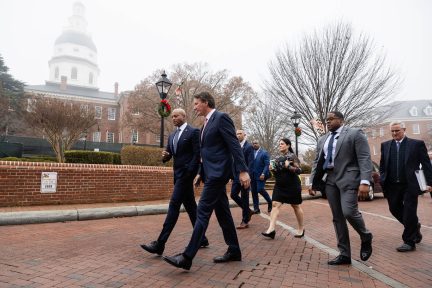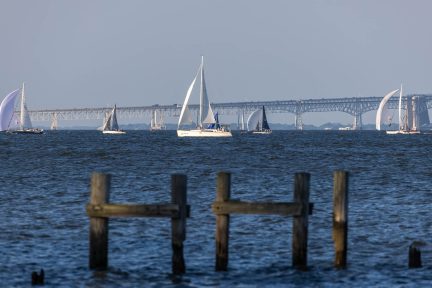Chesapeake Executive Council adopts diversity statement
Chesapeake Executive Council adopts diversity statement
Representatives from the six Chesapeake Bay watershed states, the District of Columbia, the Chesapeake Bay Commission and the Environmental Protection Agency (EPA) met today for the annual meeting of the Chesapeake Executive Council.
Established 37 years ago, the Chesapeake Executive Council, is responsible for guiding the policy agenda and setting conservation and restoration goals for the Chesapeake Bay Program, a regional watershed partnership. Members include the governors of Delaware, Maryland, New York, Pennsylvania, Virginia and West Virginia, the mayor of the District of Columbia, the chair of the Chesapeake Bay Commission and the administrator of the EPA on behalf of the federal government.
In what has become the new norm, members met virtually for the first time to discuss the challenges that the COVID-19 pandemic has brought upon their respective jurisdictions and how the continued investment in Bay restoration can be used to help the economy and public health of the region.
“As our country works to overcome a pandemic and a legacy of racial injustice, we need to have safe and accessible public spaces to recreate; places to interact with nature; sustainable, locally-produced food; clean air and water,” said Chesapeake Bay Commission Chair Gene Yaw. “When our local communities have clean water, the Chesapeake Bay will also have clean water, at no additional cost.”
However, the defining moment of this annual meeting was the adoption by the Executive Council of a historic statement re-affirming the commitment of the partnership in embracing diversity, equity, inclusion and justice in all forms, which was first included as an outcome in the most recent Chesapeake Bay Watershed Agreement. The Statement in Support of Diversity, Equity, Inclusion and Justice commits the Chesapeake Bay Program to strengthen and improve diversity, equity, inclusion and justice in all areas of the partnership, recruit and retain staff and volunteers that reflect the diversity of the Chesapeake Bay watershed, foster a culture of inclusion and respect across all partner organizations and ensure the benefits of our science, restoration and partnership programs are distributed equitably without disproportionate impacts on vulnerable populations.
Maryland Governor Larry Hogan reflected on his past three years as chair of the Executive Council before symbolically handing over the reins to Virginia Governor Ralph Northam, who was unanimously elected by the other members to succeed him.
“In my past three years as chair, we have worked together to implement real, bipartisan, common sense solutions to the challenges facing the Chesapeake Bay, and the results speak for themselves,” stated Maryland Governor Larry Hogan. “Maryland remains fully committed to this partnership as we continue making strides to preserve this national treasure.”
The Chesapeake Bay Program is governed by the Chesapeake Bay Watershed Agreement, which was signed by the Executive Council in 2014. It envisions fostering an environmentally and economically sustainable watershed with clean water, abundant life, conserved lands and access to the water, a vibrant cultural heritage, and a diversity of engaged citizens and stakeholders.
“I grew up on the Chesapeake Bay, and I am excited to take on the role of Chair of the Executive Council as we continue our critical restoration work,” said Virginia Governor Ralph Northam. “As my first official act as Chair, I call on the Council’s principal staff to immediately begin work on the diversity, equity, inclusion and justice goals adopted today. I look forward to working closely with my colleagues to build a cleaner, healthier, and more sustainable Bay.”
Quotes
“I grew up on the Chesapeake Bay, and I am excited to take on the role of Chair of the Executive Council as we continue our critical restoration work. As my first official act as Chair, I call on the Council’s principal staff to immediately begin work on the diversity, equity, inclusion and justice goals adopted today. I look forward to working closely with my colleagues to build a cleaner, healthier, and more sustainable Bay.”
- Ralph Northam, Governor, Commonwealth of Virginia
“In my past three years as chair, we have worked together to implement real, bipartisan, common sense solutions to the challenges facing the Chesapeake Bay, and the results speak for themselves. Maryland remains fully committed to this partnership as we continue making strides to preserve this national treasure.”
- Larry Hogan, Governor, State of Maryland
"Delaware stands committed to Chesapeake Bay restoration efforts and rises to the challenge of meeting our 2025 Bay cleanup goals, despite the obstacles imposed by COVID-19. We also recognize that the long-term success of the Chesapeake Bay restoration effort depends on the equitable, just and inclusive engagement of all communities living throughout the watershed. It is a priority for our state to embrace diversity, equity, inclusion and justice for the people of Delaware.”
- John Carney, Governor, State of Delaware
"If one thing is clear from the extraordinary set of challenges we face today, it's that we need to work together proactively to bring more voices to the table. This is what we're doing in Pennsylvania, and how we're turning challenges into progress, such as our "Healthy Waters, Healthy Communities" work in the watershed, that reflects increased understanding of how the environment, health, social equity and economy are connected."
- Tom Wolf, Governor, Commonwealth of Pennsylvania
“West Virginia continues our commitment to protect and improve water quality in our local rivers and streams. We are moving forward in unique ways to reach out in this challenging time and to engage new and diverse partners in our work.”
- Jim Justice, Governor, State of West Virginia
“As our country works to overcome a pandemic and a legacy of racial injustice, we need to have safe and accessible public spaces to recreate; places to interact with nature; sustainable, locally-produced food; clean air and water. When our local communities have clean water, the Chesapeake Bay will also have clean water, at no additional cost.”
- Gene Yaw, Chair, Chesapeake Bay Commission
“EPA remains committed to its role helping our partners achieve their 2025 restoration goals for the Chesapeake Bay and their local waters. This a great opportunity through our Bay Program partnership to reaffirm our agency’s commitment to the environment, to public health and to the economic benefits that come from a cleaner Chesapeake.”
- Andrew Wheeler, Administrator, U.S. Environmental Protection Agency
"The COVID-19 pandemic has highlighted some critical issues that have been on the Citizens Advisory Committee's agenda for some time. Environmental quality and public parks and wildlands are closely linked to public health. Protecting and improving the quality of our watershed is essential for the Chesapeake Bay and the citizens of our communities."
Matt Ehrhart, Chair, Citizens Advisory Committee
“Local governments are being tested more than ever due to the challenges from COVID-19. Nevertheless, local decision makers support the vision of healthy local watersheds that create vibrant economies, strong infrastructure and community health and safety. LGAC advocates for innovative research and resources to support efforts locally that have the additional benefit of improving the health of the Bay.”
- Ann Simonetti, Chair, Local Government Advisory Committee
"In light of the profound impacts of the ongoing COVID-19 crisis, the three Advisory Committees to the Chesapeake Bay Program collaborated this year on a joint statement in their respective letters to the Executive Council. All three support the Diversity, Equity, Inclusion and Justice Statement endorsed by the Executive Council and the resolve of the watershed partners to remain committed to the 2025 restoration goals. We stand together in offering our continuing support as challenges and new opportunities arise, and we hope the watershed partnership will continue to draw on our collective expertise in maintaining progress toward an environmentally and economically sustainable Bay."
- Dr. Andy Miller, Chair, Scientific and Technical Advisory Committee



